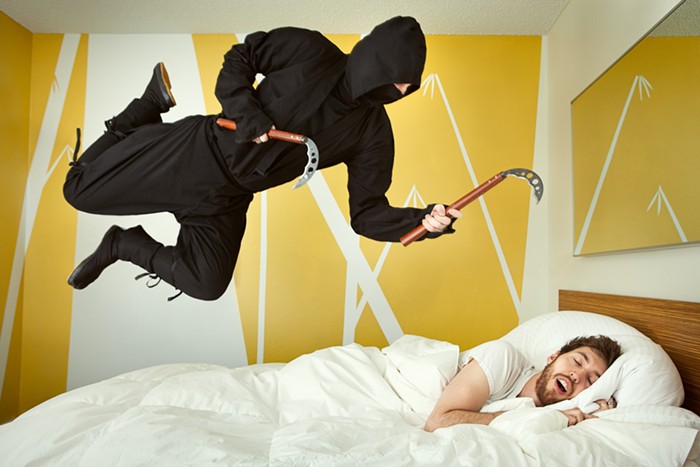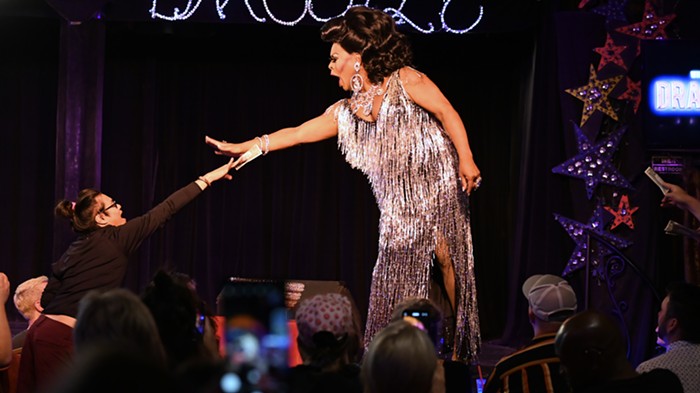PORTLAND HAS A LOT of strip clubs. It's an oft-repeated (and almost impossible to confirm) truism that this city has more per capita than any other in the world.
The casual observer could very well think of Portland's numerous houses of no-pants-dances as a manifestation of the city's liberalism. This is, after all, the city that lives and breathes the World Naked Bike Ride. When the Flaming Lips wanted to shoot a video with a ton of naked people and a giant furry vagina ball, they did it here. And Oregon strip clubs have something of a patina of progressivism, given a state Supreme Court decision that declared such performances free and protected speech.
But the true picture is far more complicated. In fact, when it comes to how clubs handle hiring, labor, documentation, and transparency, strip clubs are not exactly bastions of Portland's proud progressivism.
Strippers are not technically employees...
You might assume that clubs employ dancers—like a bartender or bouncer. That's not the case.
"You're considered an independent contractor rather than a staffer—except you exist exactly under the legal definition of a staffer, which is appropriately annoying," says “Poe” (her stage name), a former dancer who's lectured at Reed about stripping and previously authored a tax guide for strippers.
"I can name one club I know of that employs their dancers as staff members," Poe says. "And that's out of hundreds and hundreds. It's incredibly rare to be actually employed."
According to her research, most dancers don't even sign a W-9 form, the IRS documentation for independent contractors.
"Most dancers," she says, "are super-sketchily pulled in by the contractor without any tax forms being filled out at all."
She continues: "Sin industries are really hard to study, because they're not forthcoming with information. I would personally estimate—based on my research and knowledge of the industry—that close to 95 percent of dancers work under the table. That doesn't mean that they don't end up filing taxes, but the majority of them are not on the books in any way."
There are lots of benefits independent contractors don't receive. They don't get health insurance, vacation time, or sick days. They don't get maternity leave, workers' comp, or other benefits. Clubs don't need to worry about Social Security or what the minimum wage is. Dancers can, and often do, show up at clubs night after night and week after week and receive none of the benefits that, say, a janitor gets.
Working in a cash-based world affords the clubs a certain amount of flexibility when it comes to obfuscating who's employed and who isn't. If they want, strip clubs can be ad hoc, informal, and undocumented. Taryn (who did not want to give her last name) is a stripper who's worked in Oregon and elsewhere, and says that she's gone long periods of time without ever signing any kind of documentation.
"Sometimes I've just shown up and they're like, 'You're hot enough,'" she says. "I don't think my boss knows my real name, to be honest with you."
Obviously, that can be a problematic situation.
"These chicks work from [ages] 18 to 27... and no one has any income on paper," says Taryn, whose recent efforts to get a second job were frustrated by her lack of provable work history.
"No one can buy a house, no one can buy a car," she says. "Everyone goes through shady back avenues.... You need that kind of income on paper."
...but they are treated like they actually work there.
Being an independent contractor isn't all bad. In theory, contractors have a far greater amount of freedom when compared to regular employees. According to the Oregon Bureau of Labor and Industries, independent contractors inherently have a certain amount of direction and control over their work. That, in theory, includes how they dress or act, and when they show up. But according to Poe, Taryn, and other off-the-record sources I spoke to, strip clubs almost always dictate what strippers wear (heels, makeup), and more importantly, when they work and for how long.
Unlike other independent contractors (say, a coder who works from home or a freelance journalist who lives at coffee shops), employers—in basically everything but name—set strippers' schedules.
"The house mom is in charge of scheduling. She's officially a manager and usually a former dancer," says Poe. "If you're new, you're going to get the day shift—which is usually really poorly paid."
Vicki Keller, the owner of Mary's Club, sums it up this way: "[The girls] give me a schedule. I don't tell them when they have to work. They work when they ask to work. But, if they could work nine shifts in one week, I wouldn't give them all nine shifts. I would give them a portion of what they requested. Being private contractors, I basically have to ask them to work. It's just like a roofer. You couldn't tell them, 'You have to roof my house.' You're basically asking them... they work when they can and when they want. The only thing I ask is that when I put together the weekly schedule, they show up."
"If you're late once, you're gone," says Taryn, of her time at various bars. Strip clubs also advertise specific dancers on certain nights, via in-house posters, flyers, and their websites.
"No one's crying over how dancers are getting paid," says Poe. "They're making good money... but, dancers aren't covered by workers' compensation, they're expected to pay their taxes and their employer's tax, and they don't retain the abilities that you should retain as a contractor, legally."
They literally pay to work.
Imagine, for a moment, that you had to pay your boss a little something when you got to work—maybe five bucks or maybe 200, depending on what you do and how much you make. Think about being unable to sit at your desk until you, an employee, have given money to your boss. That is how strip clubs operate. "Stage fees," as they're called, are nearly universal in the industry.
Fortunately for Portland, the powers of market capitalism have kept this city's fees affordable.
"There's a lot of club competition here, so stage fees stay kind of low," says Poe, who estimates that many clubs in Portland have stage fees as low as five dollars. "The market is competitive on the labor side."
Still, fees exist, and it is technically possible for a stripper to go to work, put in a shift, and then go home having spent—not made—money. Not probable, but possible.
Strippers are also expected to hand a certain amount of their tips to the bartender, DJ, and bouncer every night. Tip amounts for staff vary. It can be a percentage of a stripper's earnings, or a flat fee as little as $5. Unlike stage fees, the custom of giving some of their tips to the bar's employees is informal, but generally expected.
"Tipping them is more of a courtesy," says Taryn, "but they'll hound you out if you don't tip well."
As a manager, arrangements like that do not sit well with Keller, who stresses that Mary's Club does not charge a stage fee per se. Instead, they ask that performers give 10 percent of whatever they make during a shift to bar staff. The owner of Portland's oldest strip club is quick to point out that her establishment is "not like those other clubs with the high stage fees and all these doormen they have to tip out. They want anywhere from 20 to 40 percent of [dancers'] earnings, I don't agree with that. A lot of these girls are young and don't know any different."
Keller notes that clubs can, if they choose, make quite a bit of under-the-table money off stage fees.
"A few years ago an owner told [an undercover Internal Revenue Service agent], 'Well, these books say this and these books say that because I make over $30,000 to $40,000 a month in stage fees and cover charges.' He got popped pretty quick."
It's worth noting that this specific anecdote could not be independently verified, but in 2010 IRS officers raided six Portland-area strip clubs, as well as four others in 2011.
How much do strippers make, though?
"A slow night can be as little as $80," says Poe, "that would be at a shitty club, maybe the day shift... but a good night? The sky's the limit."
"I make $300 to $500 a night," says Taryn, who now primarily works at an upscale club and is mostly happy with her job. However, she quickly notes that just like any other job, there are expenses.
"The stupid stripper shoes are $80 a pair and they break every damn month," she says. "A couple hundred bucks a week goes to makeup, pedicures, tanning, teeth whitening, hair extensions. If you file taxes you can totally write that off—but most strippers don't because they don't file taxes."
Taryn stresses that those items, along with paying for a gym membership and expensive lingerie, are all real expenses. She's been told by club management to tan or wear better makeup if she wanted to work. Those expenses decrease her actual take-home pay.
"If I actually sat down with a pen and paper, I think I'd make about $18 an hour," she says. Taryn notes she's worked in less prestigious clubs and made far less compared to the high-end establishment where she now performs.
According to Poe, one major silver lining is that workers in a tip-based economy are much more likely to experience a rise in real wages over time.
"I actually think from an economist's perspective that you would easily see a cost-of-living raise much more easily in a tipping economy than in an economy where there is an employer-employee relationship," she says. "Lap dances cost more now than they did seven years ago when I first worked in the industry—and when the patrons have more pocket money, tips are higher. When drinks cost more, tips rise, because we tip as a percentage of spending."
Is anyone trying to fix this labor disparity?
There are very few serious, academic studies of the labor and economic situations of strip clubs; fewer than five, according to Poe.
"And one of them was just about how they make more money while ovulating," she says. "Whatever."
A body of established case law about workers' status and rights has also failed to materialize. In 2009, one Portland stripper, Zipporah Foster, filed suit against the club where she danced for more than $40,000 in back wages and $60,000 in fees and tips she alleged that she was forced to pay. The Multnomah County Circuit Court ruled against her on one lawsuit, and settled out of court on another.
Poe notes that the cash-saturated industry has historically been a hotbed for money laundering. Clubs have been investigated and busted by the authorities, but it nearly always has something to do with tax evasion or dirty money as opposed to how they treat their workers.
"I think that the reason this hasn't gone to court is because [it is stigmatized]," says Poe. "There's also a lot of dirty money. The way they get investigated is never from a labor perspective, it's from an IRS perspective."
In the late 1990s, the employees of one San Francisco club—the now-closed Lusty Lady—did successfully unionize. The events were chronicled in the documentary Live Nude Girls Unite!, but that unionization did not set a precedent for the rest of the industry. Stage fees, off-the-record employment, and lack of benefits and work history are still the norm.
Poe says there are two things she'd do to fix it all.
"One," she says, "dancers are employees. They make an hourly wage and keep what they earn as tips, and they're protected by the law as employees. And two, they have the option to unionize."
Taryn echoes the same sentiments.
"There's no sense of any responsibility on anyone's part for anything. Our Social Security card isn't matched to anything... I've never paid taxes on my dancing money. I think it should be hourly plus tips—just like a waitress job."














